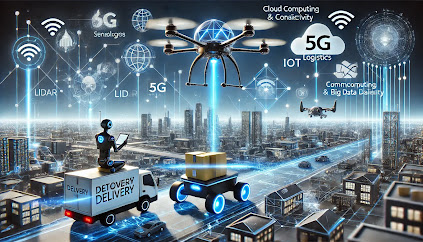Autonomous Delivery and Drones: The Future of Logistics.
Imagine ordering a package online
and receiving it within minutes—delivered not by a courier, but by an
autonomous drone or robot. This isn't science fiction; it's a rapidly evolving
reality. Autonomous delivery systems, including self-driving vehicles and
delivery drones, are transforming how goods are transported, offering faster,
safer, and more cost-effective solutions. But how do these technologies work?
What challenges do they face? And what does the future hold for autonomous
deliveries? This article will explore these questions in-depth, providing a
comprehensive look at the world of autonomous delivery and drones.
The Rise of Autonomous Delivery
The need for faster, more
efficient delivery solutions has grown exponentially, driven by e-commerce giants
like Amazon, Walmart, and Alibaba. Traditional delivery methods struggle to
keep up with increasing demand, leading to delays, inefficiencies, and rising
costs. Autonomous delivery—leveraging robotics, artificial intelligence (AI),
and drone technology—offers a viable alternative.
How Autonomous Delivery Works?
Autonomous delivery systems primarily fall into two categories:
·
Ground-Based
Autonomous Vehicles: These include self-driving delivery robots and
autonomous vans, often equipped with AI-driven navigation systems, sensors, and
cameras to detect obstacles and ensure safe delivery. Companies like Starship
Technologies and Nuro are leading the way in developing small, wheeled delivery
robots that can navigate sidewalks and streets.
·
Aerial
Drones: Drones, or Unmanned Aerial Vehicles (UAVs), use GPS navigation, AI,
and advanced sensors to deliver packages from distribution centers to
customers. These drones can fly over traffic congestion, reducing delivery
times dramatically. Amazon Prime Air, Wing (a subsidiary of Alphabet), and
Zipline are at the forefront of drone delivery.
Key Technologies Enabling Autonomous Delivery
Several cutting-edge technologies make autonomous delivery possible:
·
Artificial
Intelligence (AI) & Machine Learning: These help delivery robots and
drones navigate, detect obstacles, and optimize routes.
·
Computer
Vision & LiDAR: These technologies allow autonomous vehicles to
recognize their environment and make real-time decisions.
·
5G &
IoT Connectivity: High-speed networks enable real-time communication
between drones, robots, and control centers.
·
Cloud
Computing & Big Data: These technologies help analyze massive amounts
of data to improve logistics and efficiency.
Benefits of Autonomous Delivery
·
Speed and
Efficiency
Autonomous
drones can deliver small packages in as little as 30 minutes, bypassing traffic
and logistical delays. Ground-based robots operate 24/7, ensuring faster
deliveries, especially in urban areas.
·
Cost
Reduction
With automation,
companies can significantly cut labor costs associated with traditional
delivery services. Studies suggest that drone deliveries could reduce last-mile
delivery costs by up to 40%.
·
Sustainability
Electric-powered
autonomous vehicles and drones produce fewer carbon emissions compared to
traditional delivery trucks, contributing to greener logistics.
·
Enhanced
Accessibility
Autonomous
delivery can benefit remote and rural areas where traditional logistics are
expensive and inefficient. Companies like Zipline use drones to deliver medical
supplies to hard-to-reach locations in Africa and the U.S.
Challenges and Concerns
Despite the promise, autonomous delivery systems face significant hurdles:
·
Regulatory
and Legal Barriers
Many countries
have strict airspace regulations that limit drone operations. Governments must
develop new policies to integrate drones into commercial delivery safely.
·
Safety
and Security Risks
Drones and
robots must operate flawlessly to prevent accidents, theft, or cyberattacks.
Companies invest heavily in cybersecurity and fail-safe mechanisms to ensure
safe operations.
·
Infrastructure
and Technological Limitations
Urban areas
require proper infrastructure, such as drone landing zones and charging
stations. Additionally, AI and sensor technology must improve to handle complex
urban environments reliably.
·
Public
Acceptance
People may feel
uneasy about drones flying over their neighborhoods or robots roaming
sidewalks. Building trust through education and transparent policies is crucial
for widespread adoption.
Real-World Examples and Case Studies
·
Amazon
Prime Air
Amazon has been
testing drone deliveries for years, with the goal of delivering lightweight
packages within 30 minutes. In 2022, Amazon launched trials in select U.S.
cities, demonstrating the potential of drone delivery.
·
Wing
(Alphabet’s Drone Delivery Service)
Wing has
successfully deployed drones in Australia, Finland, and the U.S., delivering
groceries, medicines, and takeout food. The company has completed over 300,000
deliveries, proving the feasibility of drone-based logistics.
·
Zipline:
Medical Drone Deliveries
Zipline has
revolutionized medical supply chains in Rwanda and Ghana, using drones to
deliver blood, vaccines, and medicines to rural areas. This model is now
expanding to other countries, including the U.S.
·
Starship
Technologies
Starship’s
autonomous robots are already delivering food and groceries in major cities
across Europe and the U.S., showcasing the practicality of ground-based
delivery robots.
The Future of Autonomous Delivery
·
Widespread
Adoption
As regulations
evolve and technology improves, autonomous delivery could become the norm, with
drones and robots integrated into everyday logistics.
·
Integration
with Smart Cities
Future smart
cities may have dedicated drone highways and autonomous delivery hubs to
streamline urban logistics.
·
Advancements
in AI and Robotics
As AI becomes more
sophisticated, autonomous delivery systems will become safer, smarter, and more
efficient, expanding their use cases beyond e-commerce to healthcare, disaster
relief, and emergency services.
Conclusion:
Autonomous delivery and drones represent the future of logistics, offering faster, cost-effective, and environmentally friendly solutions. While challenges remain, technological advancements and regulatory progress will pave the way for widespread adoption. As companies continue to innovate, we may soon see a world where drones and robots handle most of our deliveries, transforming how goods move across cities and beyond. The revolution is just beginning—are you ready for it?






